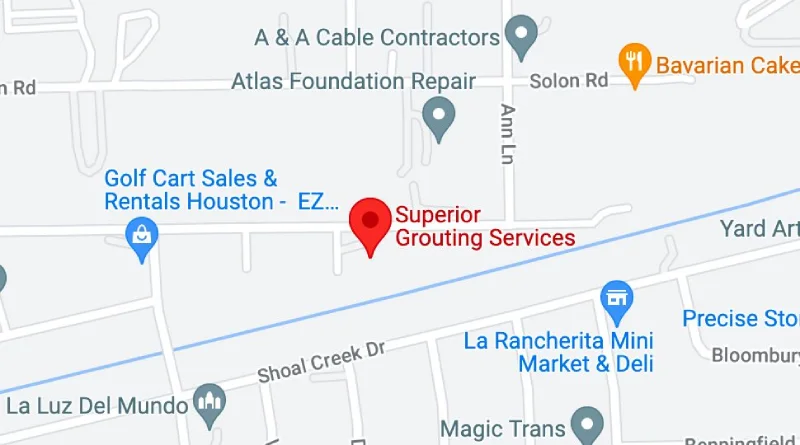What Is Annular Grouting in Houston, TX?
Annular space grouting is the process of filling around a pipe installed inside another pipe or a tunnel. Cementitious grout is used instead of leaving the space empty to ensure long-term stability of the carrier pipe and the ground or any structures above. When that work is performed in Houston, engineers must contend with high groundwater, soft Gulf Coast clays, and heavy surface loads from highways, petrochemical plants, and port facilities.
The right annulus grouting strategy keeps critical infrastructure on grade, watertight, and serviceable for decades.
Key Takeaways
- Annular space grouting protects pipelines from buoyancy, settlement, and corrosion in Houston’s unforgiving subsurface conditions.
- Choosing the correct cementitious, cellular, or polyurethane grout mix balances density, strength, and pumpability over long trenchless runs.
- Rigorous field testing—flow-cone, density, pressure, and CCTV—verifies the annulus is completely filled and free of voids.
- Grout work typically represents 3–7 % of total trenchless installation cost but avoids far higher remediation and downtime expenses.
- Partnering with a contractor experienced in compaction control, Gulf Coast geology, and ACI/ASTM testing standards ensures on-time, spec-compliant delivery.
Why Annular Space Matters in Pipeline Design
Engineers think of the annular space as the ring-shaped gap between a new carrier pipe and its surrounding casing or the native soil. Leave that void empty and you risk:
- Groundwater migration that erodes soils and carries fines into manholes.
- Buoyant uplift or differential movement that stresses joints.
- Loss of compaction around the exterior of the casing, creating sinkholes under roadways.
By filling the gap with engineered grout, you create a monolithic mass that transfers loads uniformly and seals the pathway against water, gas, or contaminant flow. In metropolitan Houston—where expansive clays swell and shrink dramatically—annular space grouting is not optional; it is a line-item spec on virtually every large-diameter water, sewer, or energy pipeline.
Typical Houston Applications for Annulus Grouting
- 60-inch water mains jacked beneath IH-45 and IH-10 frontage roads
- 48-inch sanitary force mains crossing Buffalo Bayou via microtunneling
- 30- to 42-inch product lines serving petrochemical facilities along the Ship Channe.
- High-count fiber-optic conduits in the Energy Corridor’s dense utility corridors
In every case, successful annulus grouting must offset high hydrostatic pressures, accommodate shape changes in plastic or steel carrier pipe, and protect specialty coatings from abrasion.
Material Options: Cementitious, Cellular, and Polyurethane Grouts
Although “cementitious” is the most common descriptor, several grout families exist, each with strengths tailored to Houston’s conditions.
- Neat Cement Grout (115–120 pcf): High compressive strength (1,000–1,500 psi) for short runs where pump pressure is low.
- Cellular (Foamed) Grout (50–70 pcf): Entrains micro-bubbles to lower unit weight while maintaining strength; perfect for buoyancy control in areas of shallow groundwater.
- Polyurethane Grout (60–75 pcf rising foam): Rapid-set, expansive material that excels at sealing local leaks or voids discovered post-grout. Crews often inject polyurethane as a secondary treatment if CCTV reveals weeps after the primary cementitious fill.
Selecting the right mix involves balancing density against the groundwater table, desired compressive capacity, and the length of the pumping run. Most Houston specifications target densities 10–15 pcf higher than local groundwater (≈63 pcf) to prevent uplift.
Step-by-Step Annular Space Grouting Workflow
1. Pre-Grouting Checks
- Survey confirms grade, spacers, and pipe alignment.
- Flow-cone and foam-density cup tests establish baseline viscosity and density.
- Hydrostatic pressures are modeled so the crew understands allowable pump limits and potential compaction effects on surrounding soils.
2. Pumping the Grout
- Tremie tubes are inserted at the lowest end of the casing.
- Grout is introduced slowly to minimize hydraulic fracturing of clay layers.
- Field techs record pressure, volume, temperature, and density every 5 yd³ in accordance with ASTM C942 and C109.
- Grout rises until it flows steadily from the highest vent, proving the annular space is full.
3. Quality Assurance
- Vent lines stay open until bleed water ceases.
- 24-hour cubes or cylinders verify compressive strength.
- CCTV or laser profiling confirms no residual voids, and that carrier pipe coatings remain intact.
4. Post-Grout Activities
- Excavations are backfilled and compacted to project spec.
- Final documentation—density logs, pressure charts, and test reports—is delivered to the owner for record keeping.
Addressing Houston-Specific Challenges
Soft Clays and Settlement
Houston’s smectite-rich clays expand when wet and contract when dry. An oversized annular space grants the grout a buffer to compress slightly, equalizing radial forces on the pipe. Proper surface compaction after grouting further reduces settlement risk.
High Groundwater and Buoyancy
Cellular or cement mixes with densities around 90 pcf counteract uplift while avoiding overstressing the pipe wall. Where buoyancy loads are extreme—such as bayou crossings—engineers may switch to 110 pcf grout or add external hold-down straps.
Long Pumping Runs
Jack-and-bores exceeding 500 ft demand staged ports every 150 ft to reduce line pressure. Crews monitor temperature because hot grout can break down foam, changing density mid-run. Modern high-output pumps with variable speed drives help keep flow laminar.
Environmental Protection
Houston’s wetlands and waterways impose strict spill regulations. Contractors line containment pits, use drip-less couplers, and maintain emergency spill kits onsite. Any polyurethane injections are performed with non-toxic, closed-cell formulations tested for leachate.
Budgeting and Scheduling Insights
Factor grouting carefully into the early cost model:
- Mix Design & Lab Testing………………………15–20 % of grout line-item
- Mobilization & Pumping Equipment………………25–30 %
- Materials (cement, fly ash, foam agents)……40–45 %
- QA/QC (cylinders, CCTV, reports)………………10–15 %
On a 600-ft, 48-in. force main, total grout cost might land between $80,000 and $120,000, but skipping a full annular fill can lead to multi-million-dollar remediation should the carrier pipe float or settle.
Schedule impacts are modest—most annular space grouting operations finish within one or two night shifts. Nonetheless, couples planning should reserve 12 hours of curing before traffic lanes reopen or other activities begin on top of the line.
Choosing the Right Contractor
The contractor you hire is the single greatest predictor of success. Look for:
- ACI Level I & II certified grout technicians on crew
- Documented experience with annular space grouting on TxDOT and City of Houston project.
- Modern pumps capable of ≥100 yd³/hr with variable pressure control
- In-house QA/QC lab or a standing relationship with a local certified lab
- Proven polyurethane injection capability for contingency work
Ask for three references on comparable diameter and length bores, and review their compaction and density logs before awarding the work.
Conclusion
In the Greater Houston area, annular space grouting is mission-critical for any large-diameter pipeline installed inside a casing or mined tunnel. The combination of high groundwater, soft clays, and heavy industrial loads demands that the annulus be filled with a purpose-designed grout—cementitious, cellular, or polyurethane—to ensure long-term stability and regulatory compliance. By understanding the unique challenges of Gulf Coast geology, selecting the right mix, and enforcing rigorous QA/QC, owners can protect multi-million-dollar assets for generations.
Engage a qualified contractor early, budget realistically, and insist on thorough documentation. Your pipeline—and Houston’s infrastructure—will thank you.


